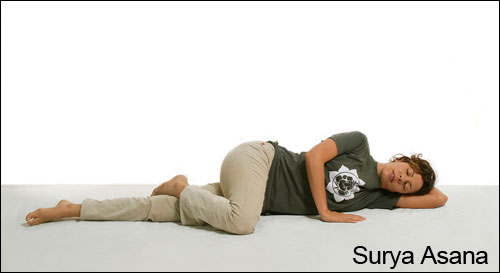|
Yoga and tantra emphasize the balance between the two halves of the body. The right side of the body is considered to be of masculine nature, endowed with warm, golden, positive, pranic energy, and is represented by the pingala nadi, the energy channel along the right of the spinal column.
The left side of the body is considered feminine and endowed with cool, silvery, negative, apanic energy and is represented by the ida nadi, the energy channel along the left of the spine.
In yoga we try to understand, harness and bring about a balance between the energies of the two halves of the body, which is the primary objective of hatha yoga. The best practical example of this concept is found in the study of the nasal cycle.
The nasal cycle is a rhythm of nasal congestion and decongestion that occurs naturally every 60 to 240 minutes. The concept of the nasal cycle and an understanding of its role in our life have long existed in Indian science. It has been observed, for instance, that certain activities are appropriate when the nasal cycle is in different phases:
Activities best suited in lunar swara (left nostril open, right nostril closed)
Activities best suited in solar swara (right nostril open, left nostril closed)
Activities prescribed in sushumna swara (both nostrils open)
It is also said that in order for conception to occur, the man and woman must be dominated by opposing swaras during intercourse (and the gender of the child will be reflective of the male's swara at that time). It is also claimed that speedy relief can be gained when suffering from certain conditions (such as headache, cold, hypertension, acidity or asthmatic attack) by changing the swara pattern (i.e. the open nostril).
Studies have shown that right nostril breathing significantly increases blood glucose levels, whereas left nostril breathing lowers it -- and that left nostril breathing produced decreased systolic, diastolic and mean blood pressures.
How to Change Your Breathing (Swara) Pattern
Applying the pressure of a crutch in the axilla (under the armpit), pressure on the thorax while sitting and also the act of lying down on the side, all affect the pattern of nasal dominance. All these actions cause decreased airflow in the same side nostril and increased airflow in the opposite side nostril. With each of these techniques, the swara pattern usually takes only a minute or two to start to change.
One simple but effective technique for regulating the nasal flow is the nadi pranayama.
Nadi Pranayama
This simple pranayama technique consists of two practices: The surya nadi pranayama and the chandra nadi pranayama. Surya means "sun," which refers to the positive (right side) of the body; and chandra means "moon," denoting the negative (left side).
Surya Nadi Pranayama
-
Begin by lying on the left side of the body, resting the head on your left arm.
-
Draw your right leg forward and place it on the floor, hooking your foot overtop of your left knee. (This is known as surya asana).
-
Place your right hand over the middle of the diaphragm (at the lower margin of the ribs).
-
Breathe deeply in this position until the right nostril becomes dominant (clear).
* Chandra Nadi Pranayama is performed in exactly the opposite manner, rolling over and lying on your right side.
Yogacharya is the Director of International Yogalayam, Editor of The Yoga News, and creator of the yoga training programs at TheYogaTutor.com
Return to Yoga Articles Main Page
|






